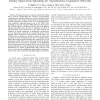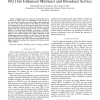VTC
2010
IEEE
13 years 10 months ago
2010
IEEE
—Coordinated multi-point transmission/reception (CoMP), in which base stations (BSs) cooperate during the downlink, has been identified as a tool for improving user rates and mi...
VTC
2010
IEEE
13 years 10 months ago
2010
IEEE
—In order to evaluate the performance of new mobile network technologies, system level simulations are crucial. They aim at determining whether, and at which level predicted link...
VTC
2010
IEEE
13 years 10 months ago
2010
IEEE
Abstract—In this paper we present an overview of a vehicleto-vehicle radio channel measurement campaign at 5.6 GHz. The selected measurement scenarios are based on important safe...
VTC
2010
IEEE
13 years 10 months ago
2010
IEEE
— in this paper we address the problem of reducing the feedback for the downlink transmission in multi-carrier systems. In these systems multiple Component Carriers (CCs) are agg...
VTC
2010
IEEE
13 years 10 months ago
2010
IEEE
— Adaptive network coded cooperation (ANCC) has been proposed as an effective scheme to combine network and channel coding for cooperative wireless networks by matching network-o...
VTC
2010
IEEE
13 years 10 months ago
2010
IEEE
—Game theory has been applied to model power control in wireless systems for years. Conventional power control games tend to consider unlimited backlogged user traffic. Differen...
VTC
2010
IEEE
13 years 10 months ago
2010
IEEE
Abstract—We evaluate the interference limited spectral efficiency of a small cellular network using measurements with 3 sites at an ISD of 750 m. Each 3-sector site is equipped ...
VTC
2010
IEEE
13 years 10 months ago
2010
IEEE
—This paper proposes a cooperative space-time coding (STC) protocol, amalgamating the concepts of asynchronous cooperation, non-coherent detection as well as Distributed Turbo Co...
VTC
2010
IEEE
13 years 10 months ago
2010
IEEE
—Applying network coding on broadcasting service is known to reduce times of transmission in the process of recovering the loss packets. In previous design, coding coefficients ...
VTC
2010
IEEE
13 years 10 months ago
2010
IEEE
—Most of geographic routing approaches in wireless ad hoc and sensor networks do not take into consideration the medium access control (MAC) and physical layers when designing a ...



